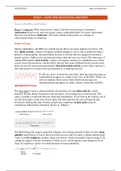PSY/IPN1023 Body and Behavior
TASK 6 – SLEEP AND BIOLOGICAL RHYTHMS
Sources: Breedlove and Carlson
Sleep is a behavior. What characterizes sleep is that the insistent urge of sleepiness
(motivation) forces us to seek out a quiet, warm, comfortable place; lie down, and remain
there for several hours (behavior). We tend to think of sleep more as a change in
consciousness than as a behavior.
Stages of sleep
During wakefulness, the EEG of a normal person shows two basic patterns of activity. The
first, alpha activity, consists of regular, medium frequency waves, and is produced when a
person is resting quietly, not particularly aroused or excited and not engaged in strenuous
mental activity. Alpha waves are more prevalent when the eyes are closed. The other type of
waking EEG pattern, beta activity, consists of irregular, mostly low-amplitude waves. Beta
activity shows desynchrony, which reflects the fact that many different neural circuits in the
brain are actively processing information. Desynchronized activity occurs when a person is
alert and attentive to events in the environment or is thinking actively.
If cells are active at about the same time, their electrical messages as
synchronized at appear as a large, clear wave in the EEG. If they are
active at random (beta waves), their electrical messages are
desynchronized and appear as small, chaotic waveforms in EEGs.
The first stage if sleep is characterized by the presence of some theta activity, which
indicates that the firing of neurons in the neocortex is becoming more synchronized. This
stage is actually a transition between sleep and wakefulness. If you look at the eyelids, you’ll
see that from time to time they slowly open and close and that the eyes roll upward and
downward. During this time of sleep, people may experience hypnic jerks (muscle
contractions followed by relaxation; known as ‘falling’).
The EEG during this stage is generally irregular, but contains periods of theta activity, sleep
spindles (short bursts of waves that occur between two and five times a minute during stages
1 and 3) and K complexes (sudden, sharp waveforms, which are usually found in stage 2). K
complexes appear to be the forerunner of delta waves, which appear in the deepest level of
sleep. K complexes consist of isolated periods of neural inhibition.
,PSY/IPN1023 Body and Behavior
The person is sleeping soundly now; but if awakened, she might report that she has not been
asleep. About 15 minutes later the volunteer enters slow-wave sleep, signalled by the
occurrence of high-amplitude delta activity.
About 90 minutes after the beginning of sleep, we notice an abrupt change in a number of
physiological measures recorded from our volunteer. The EEG suddenly becomes mostly
desynchronized, with occasional occurrences of theta waves, very similar to the record
obtained during stage 1 sleep. We also note that her eyes are rapidly moving back and forth
beneath her closed eyelids. Besides, the EMG becomes silent; there is a profound loss of
muscle tone. This stage of sleep is quite distinct from the quiet sleep in the earlier stages it is
usually referred to as REM (rapid eye movement) sleep.
By most criteria, stage 3 is the deepest stage of sleep; only loud noises will cause a person to
awaken, and when awakened, the person acts groggy and confused. In contrast, during REM
sleep a person might not react to most noises, but he or she is easily aroused by meaningful
stimuli, such as the sound of his or her name. Also, when awakened from REM sleep, a
person appears alert and attentive.
If you would wake someone up during REM sleep and ask him what was going on, he will
almost certainly report that he was dreaming. The dreams of REM sleep tend to be narrative
in form, with a story-like progression of
events. On the other hand, if you would
wake someone during slow-wave sleep and
ask ‘where you dreaming’, he will most
likely deny.
During the rest of the night, a person’s sleep
will alternate between periods of REM and
non-REM sleep. Each cycle is
approximately 90 minutes long, with REM
sleep for 20-30 minutes.
, PSY/IPN1023 Body and Behavior
Figure above and on previous page; note that most slow-wave sleep occurs during the first
half of the night. Subsequent bouts of non-REM sleep contain more and more stage 2 sleep,
and bouts of REM sleep become more prolonged.
During REM sleep, we become
paralyzed; most of our spinal and
cranial motor neurons are strongly
inhibited (the ones that control
respiration and eye movements are
not inhibited).
At the same time, the brain is very
active. Cerebral blood flow and
oxygen consumption are
accelerated. In addition, during most
periods of REM sleep, the genitals
will become at least partially active
(erection, vaginal secretion).
The table below shows differences between REM sleep and Slow-Wave Sleep (SWS).





